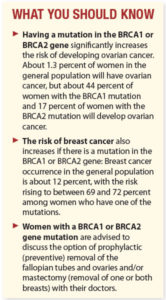Watch for Warning Signs of Ovarian Cancer and Know Your Risk
Ovarian cancer is not the type of cancer that most frequently affects women, but it does have one of the lowest survival rates of all cancers.
One reason for this is that ovarian cancer often goes undetected until it has reached an advanced stage, when the cancer has metastasized (spread) to other organs and treatment is often ineffective. Sometimes, there are no symptoms, and other times, symptoms are missed, or they are vague and dismissed as nothing to worry about.
“A diagnosis of ovarian cancer is usually delayed. Most women either have no symptoms, or they may have vague symptoms for months,” explains Melissa Frey, MD, a gynecologic oncologist at Weill Cornell Medicine.
As with all cancers, the earlier the cancer is caught, the sooner it can be treated and the higher the chance of survival. This is why it’s so important for women to know what to look for and to report any suspicious symptoms to their doctors.
What to Watch For
“Symptoms of ovarian cancer include abdominal pain, bloating, fatigue, change in bowel function (diarrhea or constipation), or a change in appetite,” says Dr. Frey.
Other symptoms include pain or pressure in the pelvis or lower back, changes in urinary habits (especially urinary urgency and frequency), indigestion, feeling full quickly when eating, and shortness  of breath, which can indicate that the disease has spread to the lungs.
of breath, which can indicate that the disease has spread to the lungs.
For women who do have symptoms, the symptoms may be caused by any number of factors or conditions, so it’s not uncommon for the cancer to go undiagnosed for a lengthy period of time.
“Unfortunately, many women often see a number of doctors before the diagnosis is made. As gynecologic oncologists, we are trying to educate women and doctors how to detect early signs of ovarian cancer so women can avoid a delay in diagnosis,” says Dr. Frey.
Unlike the Pap test, which screens for cervical cancer, there is no standard screening test that can reliably detect the presence of ovarian cancer.
Know If You’re at High Risk
Risk factors for ovarian cancer include older age, being overweight or obese, a family history of ovarian, breast, or colorectal cancer, hereditary ovarian and breast cancer syndrome (a genetic mutation), and late pregnancy after age 35 or no pregnancy carried to term.
Women who have family members with breast, ovarian, fallopian tube, or peritoneal cancer should be evaluated to see if they have a family history that is associated with a harmful mutation in the BRCA1 or BRCA2 gene. If they do, then genetic testing is usually advised.
“Some of the direct-to-consumer genetic testing options are popular for obtaining ancestry information, and they may also provide information on some cancer syndromes. However, it is important for women to know that this testing is not comprehensive. Women at increased risk should meet with a certified genetic counselor to make sure they are getting the genetic testing that will yield the most informative results based on their personal and family history.”
When Cancer Is Suspected
“For women with an elevated risk of ovarian cancer, a gynecologist may consider screening with pelvic ultrasound and a blood test for a tumor marker called CA125. However, the woman and her gynecologist must discuss the limitations of these tests, as we currently have no evidence that they can reliably detect ovarian cancer in its early stages,” explains Dr. Frey.
If cancer is suspected after initial testing, a biopsy (examination of a tissue sample) is performed.
“Also, all women should be seen regularly by a gynecologist, even during their postmenopausal years. If a gynecologist suspects a pelvic mass on exam or if a woman has any symptoms of ovarian cancer, she should undergo evaluation with ultrasound or CT scan and possibly a blood test,” says Dr. Frey.
The post Watch for Warning Signs of Ovarian Cancer and Know Your Risk appeared first on University Health News.
Read Original Article: Watch for Warning Signs of Ovarian Cancer and Know Your Risk »

